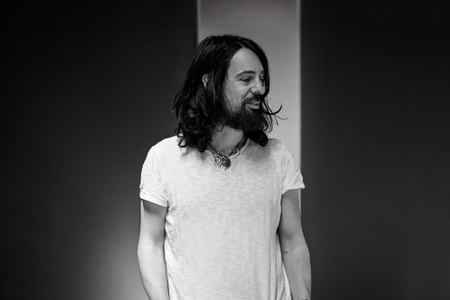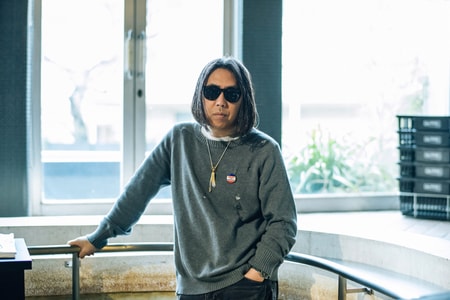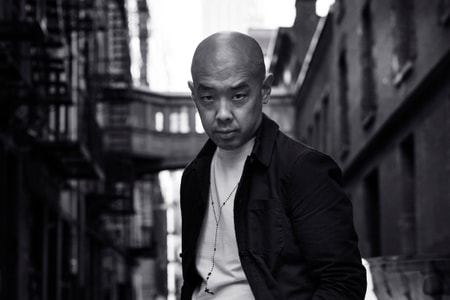
What have been the biggest challenges you’ve faced since starting SHOWstudio?
Broadcasting, defining fashion films as a medium—there’s reluctance for people in the fashion world to engage on the internet. We are much better at it now, but when people in the fashion world first came along at the end of the ‘90s, they really weren’t engaging at all. It took quite a long time for lots of people to realize that the internet is the future of fashion, and magazines probably aren’t.
What do you think were some of the factors that changed those people’s minds?
If you’re doing a live broadcast, it’s much more thrilling to have a live audience watch what you are doing and responding to what you are doing. Also the figures, which are really exciting for people who want to get their messages across, to a wider sort of audience. I think it really clicks with the fashion world where we did the Plato’s Atlantis show for Alexander McQueen, which tragically was his last show, but that was broadcasted live to the public. Six million people tried to watch it at once. All of a sudden you have a huge audience that wants to come and see what you are doing. I think that was a real wake-up call for the fashion industry: there was an audience out there and there was an audience who actually really wanted to partake and to be involved in things.
How has SHOWstudio navigated the current state of the fashion industry?
I think it’s always been the people who I want to work with have always wanted to work with me, luckily. When I say “okay, you should redo a fashion film,” they would change the idea and send it to me. So a lot of the sort of world I was dealing with was naturally there. So I haven’t really had to convince people, it’s only the people that don’t understand the power of the internet that still stick to magazines you have to convince.
People who are more forward-thinking got it straight away. It’s just the rest of the industry. For instance, with John Galliano back in the end of the ‘90s, we were already talking about live streaming and he got it straight away. It’s people in between… the marketing people didn’t really get it. Now they’re all trying to work at how to get involved now, figuring out what’s the best way to be on the internet. You have a very free audience out there, people are allowed to express their opinions on what you do and are encouraged to do so. It’s a lot freer at the moment and a lot more exciting than what it was 20 years ago. When I started SHOWstudio, the industry was not as open-minded.
People like Gosha Rubchinskiy, or Virgil from Off-White, people have their own following. They don’t need a fashion press now. We’re happy to engage with them, but we don’t need them. The followers are pretty dedicated to the fandoms themselves; I think there’s a very new structure happening in the current industry. Before, it was very heavily weighted in terms of content of the magazines and not the audience. Now it is much more weighted in terms of the audience than the designers, so I think that is much more refreshing. I find the times we are living through kind of interesting in an exciting way, there’s lot of different proposals that have been put forward. People are just starting. You can get into it now.
As streetwear’s role in the industry shifts, is it a focus to involve more streetwear on SHOWstudio?
I think it’s not so much of a focus as we respond to where the excitement is. There are new brands coming out like Alyx and Off-White™ who are quite new and are working in a totally different system. Coincidentally, both Virgil and Matt Williams were assistants of Kanye West, who I work with quite a lot. They come from that world. I think what Kanye did was to really change things; I think they are really changing things.
So there is a new status quo. I think we are not trying to focus on sportswear or streetwear or whatever you want to call it, it’s just that is where there’s a lot of excitement. I think between sportswear and couture, for instance, all these divisions are starting to become less relevant. You’re just watching people doing interesting things. Also, the idea of people being just one thing like how they are only a photographer, a filmmaker, or just a painter… it’s no longer true. I think people have a general set of skills and the word, rather ungracious word I hear a lot is “generalist,” which says, you know, you have lots of different skills. I think that is much more of a contemporary way of being. That is much more exciting than someone being good at one thing.
Do you have any projections or thoughts on where the industry is heading?
Yes, I think we are about to go through a huge change both in terms of society and of course, image making. I think once you start to really, seriously look at the world of virtual reality, artificial intelligence, and the robotis—which are the three big things coming our way––you start to look at a very, very different landscape and imagery if you think about how you will see images in the future.
There could be hotspots around your room where different things could happen, whether it is a film or maybe a 3D figure you can move around and look at—all these science fiction stuff you’d see from a film or book 20 years ago.
What’s been your highlight of 2017?
Photographing LeBron James was kind of my highlight of the year. That was something for Nike a couple months ago in LA. That was a huge moment, to be honest. Working with Travis Scott was fantastic, there were lots of good highlights; it keeps on going on you know? Working with David Beckham. There’s a nice crossover between sport and fashion at the moment. So people like LeBron James and David Beckham who are huge in their own industries get me really excited.
I’ve always worked with models on Instagram such as a girl I found called Caitlin Kitten who has a cat eye syndrome, which changes the shape of the face and the eyes. Most of my models have been people that I found on Instagram and that has been a change that’s been happening for a couple of years. Those are the biggest changes these years. One thing while I am thinking about it, I had an exhibition in Seoul, South Korea; that was my first major solo exhibition so that was really important.
What are your short-term and long-term goals for SHOWstudio and yourself personally?
Well, short-term goals would be to get into working more with virtual reality and artificial intelligence. Long-term goal is to recreate myself in AI. I’d rather be part of my own creation. Long-term goals for SHOWstudio is to open the studios in different places in the world. SHOWstudio is a very easy model to replicate—it’s a studio but smaller so everything would come live to you. I want it to be LA, I want it to be China, I want it to be in many different places. I find LA very exciting; I spend lots of time there when I print my art prints, I print in LA. It’s a social eye opener to be in. I like the place, I like the people, I like the climate, and I like the vibe. There’s lots of different things in the long term I want SHOWstudio to be, like getting it to be a 24-hour fashion broadcast would be a really good long-term goal.









